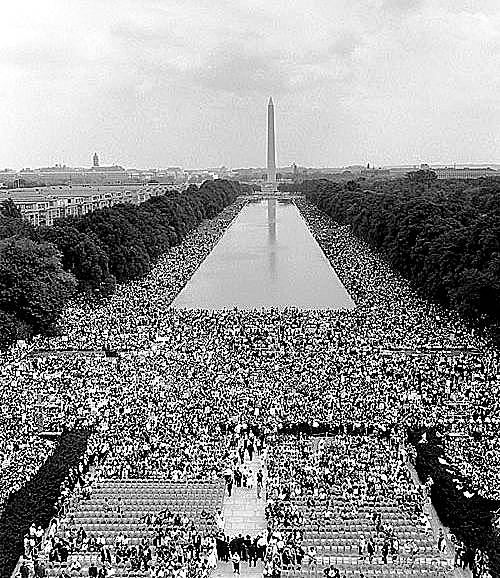BREMERTON — An event almost 50 years ago in Memphis, Tennessee, not only shook the foundation of America to a breaking point, it reverberated throughout the world.
Even today, scholars debate whether this nation has fully recovered from the murder of America’s most revered and respected crusader for equal rights.
At 6:01 p.m. on April 4, 1968, white supremacist James Earl Ray fired a single bullet from a rifle at Dr. Martin Luther King Jr., as the civil rights leader stood outside his second-floor motel room prior to giving a speech that night.
King’s death tossed the nation into a fiery turmoil of recrimination and anger that the African-American orator had so forcefully attempted to restrain during a decade of peaceful demonstrations and strikes. He sought to change the nation’s social structure, to provide an equal footing for blacks in schools, the workplace and at the ballot box.
On the night of King’s assassination, major cities in the U.S. were plunged into deadly riots that destroyed large swaths of downtown businesses and killed scores of people, both black and white.
A beacon of promise
But just five years earlier, on Aug. 28, 1963, King almost singlehandedly raised the issues of segregation, equality and economic freedom to a wide audience of Americans. Standing at a podium on the steps of the Lincoln Memorial and speaking into an overmatched sound system in front of 250,000 people in the nation’s capital, the Atlanta preacher and civil rights organizer changed the national dialogue into an urgent call for racial harmony and equal rights for all, regardless of race or ethnicity.
Drew Hansen, a Harvard and Yale Law School graduate, and later an Oxford University Rhodes Scholar, became intrigued with King’s “I Have a Dream” speech. He used material gathered for a series of college papers he wrote on the topic and crafted them into the book, “The Dream: Martin Luther King Jr. and the Speech That Inspired A Nation” published in 2003 by Harper Collins.
Hansen, who now is a Democratic state representative from Bainbridge Island, wrote an opinion piece for the New York Times in 2013 on the 50th anniversary of the speech. Hansen wrote that King’s masterful words “I have a dream” were improvised, unlike famous lines in other notable American speeches.
He had used the line in extemporary addresses given at other gatherings around the country. But, according to Hansen’s account, the line hadn’t been included as part of a draft King and his advisers had outlined. Believing he wouldn’t have more than five minutes at the microphone, he omitted it from his remarks in favor of words about housing discrimination and jobs.
Working alone on his remarks until 4 a.m. the morning before the march, King included passages from the Bible, the Declaration of Independence and the Constitution, as had President John F. Kennedy in his televised address to the nation in a call for civil rights legislation.
Departing from his prepared speech as he neared the end, King improvised a call for activists to return to their communities and continue their fight for equality. At that point, gospel singer Mahalia Jackson, who had inspired the civil rights leader with two spirituals she sang on stage — “I Been ’Buked and I Been Scorned” and “How I Got Over” — cried out from off-stage to King: “Tell them about the dream, Martin!”
King, hearing the admonishment, lowered his baritone voice into the microphone and spoke the now-famous words, which began, “I say to you today, my friends, so even though we face the difficulties of today and tomorrow, I still have a dream.”
Asked about how King, if alive today, would respond to the fractured American political and societal landscape in 2018, Hansen said the civil rights leader would have to acknowledge the progress that has been made.
“No one would disagree that the opportunities now available to minorities, including blacks, far outweigh those available 50 years ago,” Hansen said.
He said the social landscape has dramatically been altered through the efforts of inspirational leaders like King and Ralph Abernathy, another civil-rights movement giant. The lingering issue today for African-Americans continues to be racism and discrimination that is now mostly hidden and applied in more subtle ways.
The rise of the white supremacist movement and strident nativism over the past few years, Hansen said, obscures the fact that racism isn’t a phenomenon that began in the Jim Crow South, and it’s not a hangover from the days of slavery.
“The fact is that racism has been part of America since its founding,” Hansen said, adding that it has been used as a manipulative tool to oppress and marginalize non-whites for centuries.
For those who commemorate the birth of Martin Luther King Jr. on Jan. 15, it’s a reminder that the ugly specter of racism, while not as obvious to Americans living in the early stages of the 21st century, is alive in a disturbing segment of the public today.
And it probably wouldn’t be a surprise to one of the greatest orators of his day.
— Bob Smith is an editor for Kitsap News Group. Contact him at rsmith@soundpublishing.com.



